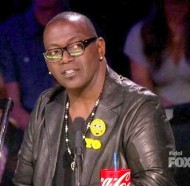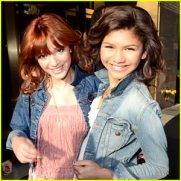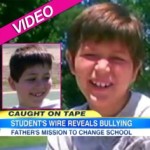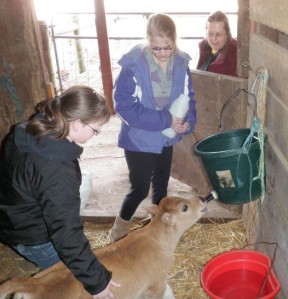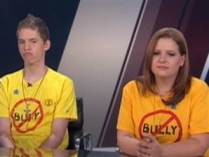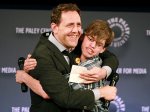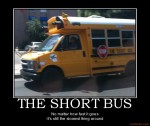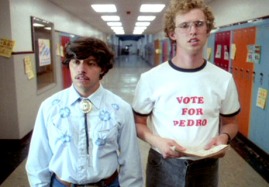When my daughter was diagnosed with autism, someone gave me the essay “Welcome to Holland. Some people believe that this essay about raising a child with a disability is comforting. I found it annoying. The author, Emily Perl Kingsley, compares raising a child with a disability to preparing for a trip to Italy, and getting off the plane and finding yourself in Holland. I know that the author had good intentions: she didn’t want people to be so consumed by their child’s disability that they miss the wonderful things about their child. But you just can’t hear that message in the early stages of angry, raging grief.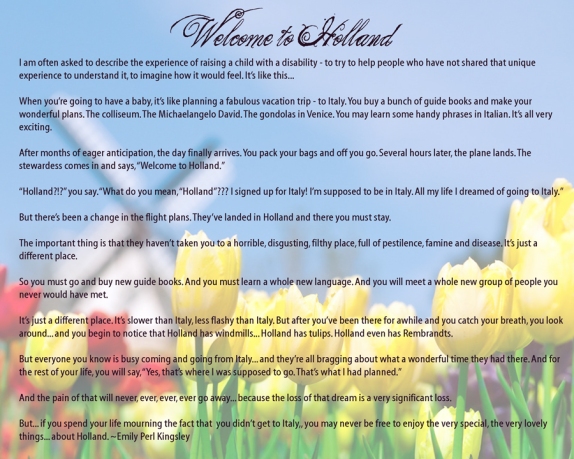
When I read the essay after my daughter was diagnosed with autism, I reacted to the part where she said: “they haven’t taken you to a horrible, disgusting, filthy place, full of pestilence, famine, and disease. It’s just a different place.” To me, autism has not been just a different place. The first years were terrifying and lonely.
The first years of autism are nothing like Holland, with beautiful tulips and windmills and delicious cheese. When parents step off the airplane of diagnosis into Autismland, it looks pretty barren. Many families who have a child with autism feel isolated and separated from the communities of school, church, and recreation. Even with an accepting community, how many would return after their child had a screaming, flailing tantrum? Or even if he just loudly quotes Spongebob in a somber moment? Parents of typical kids get the group tour with jolly companions, drinking and laughing as they journey from kindergarten registration to college application. Parents of kids with autism are on their own in a strange inhospitable country. With a diagnosis of autism, it wasn’t just about whether my child would talk, but about whether she would have a future: would she ever be able to work, get married or have a family? For a parent, this treeless, lonely country looks nothing like Amsterdam or Rome.
Even for families of high functioning kids who learn side -by-side with typical children in regular education, there is a huge chasm of separation. Once when we were preparing an after-school activity, one mom said to me,”I don’t know what I’d do if I had a child like yours”. Her statement has bounced around in my head for 8 years, and I remember it every time I see her jogging down the road. She was commenting on the deep canyon that separates her world and mine. I could see her micro-expressions of unconscious disgust and superiority, that’s what stays with me.
Some of the separation from the mainstream parents reflects my own social awkwardness….even before autism, I never knew how to do the normal mom talk about Longenberger baskets or jewelry parties. Some autism parents have the knack of making others feel at ease and fitting in. For the rest of us, school events are particularly stressful. Autism parents go on more field trips than the other parents, and this time of year I hear the field trip stories from parents every day. The brave parents of kids with autism tell me about the pain of watching their children who can’t read the social cues. They tell me about watching when no one chooses their child to be a partner on the bus. They see the other parents watching the lunch drama, when all of the kids choose where to sit. The other parents don’t want their child to be forced to sit next to ours, and wish we would accept sitting at the unpopular table. During field trips and class parties, parents are finally granted their foolish wish to be a fly on the school walls– and they see the vast ocean that their child with autism needs to cross to be accepted.
I spent the elementary years helping out in Girl Scouts, backstage, and on field trips. It would have been easier if I had been one of the moms who was naturally good at the PTA thing, always chipping in to help with the endless fundraisers. Maybe that would have given me some social capital. In those years, I thought I had some sort of special dispensation for having a child with a disability, and I just didn’t realize that I didn’t get a free pass at all — rather, I needed to do twice as much, while not talking too much about my other life of therapies and supplements. Within our own networks, autism parents overlook forgotten phone messages and dropped balls, but the rest of the world is not so forgiving.

When I called up the staff of Girl Scouts of Eastern Pennsylvania to ask whether my daughter with autism could be a program aide helping younger children, they said “Sounds great! We have a staff member with Asperger’s who just did a training for us !” Juliette Low, the founder of Girl Scouts, was deaf.
Participating in activities required all of my acting skills, putting on a game face to cover up my intense anxiety. Like the time that an elderly Girl Scout came and showed the Brownie troop her ancient collection of historical uniforms. I walked my fidgety child around the perimeter of the room, around and around, through the endless presentation, knowing that all the moms were watching us. The very first girl Scout meeting, I remember my daughter standing on the tables and lying on the floor. I needed to gather my courage before every meeting. We went on overnights, camping in tents, on a battleship, in a church basement, at the Game Preserve. The popular clique negotiated who slept next to who, and ran off to the bathroom together to gossip. I comforted the crying girls after lights out. Girls Scout rules don’t allow adults to sleep in the same platform tent with girls. Would the lantern outside my door stay lit all night? Would the girls wake up if their tent-mate had to use the latrine? Would anyone get lost in the woods in the dark? I slept fitfully, listening for every noise. I came home from each experience exhausted from managing other children’s needs while trying as best I could to help my own kid look normal. Or less different.
We moved on to other activities in middle school. We did High School Musical and Aladdin. We went on an overnight band trip . I kept supporting backstage, finding missing props, and giving cues for entrances. It was fun, but still grueling. The mommy cliques dwindled as the scornful glances of the young teenagers began to emerge. For many families with autism, puberty means going deeper into quicksand. But for us, it was time to start stepping back.
This year in high school, there was an overnight trip with school: 3 long days. None of the parents went on the trip. I didn’t see whether anyone sat with her on the bus, but I saw the exuberant Facebook message she sent on her Kindle from the bus: “On my way to Boston, yay!” I only texted the teacher for reassurance once, but I was still drained by the time we picked her up. The teachers said she had fun, but she doesn’t believe in sharing unnecessary information with adults, so we didn’t hear much detail.
Stepping back takes different forms. The last three years we’ve been in the Young Playwright’s Festival with Touchstone Theatre. The first year I was a helper, but last year I took the plunge and I auditioned. I was no longer a spectator and observer, there to give direction to my child –this time I got on stage too. I was too busy with my own role as a spinning wall and dancing tree to worry about anyone else. This year we were mourners in The Sad Story of Mrs. Donut Person, by Biance Acosta. Making people laugh is great fun.
It’s been a long journey, and as I look back, I am amazed to see the rough terrain that we crossed. The journey was not what I expected, but not the worst that I feared. There’s still a ways to go, but now I can stop once in a while to find a flower sprouting up between the rocks. 
We can only be said to be alive in those moments when our hearts are conscious of our treasures. ~Thornton Wilder






